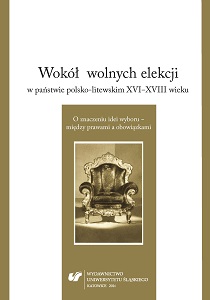

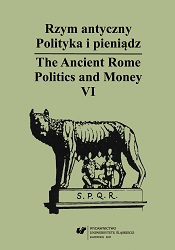
The Głubczyce-Racibórz land, that is, the titular “northern entrance” of the Moravian Gate, is an area of the most numerous findings of the Roman coins north of Danube. First mentions regarding the land appear in the literature on the subject as early as at the beginning of the nineteenth century. In the present article the author discusses the state of the research on the said findings, focusing mainly on the years 1945—2013. While the mentioned period remains his main point of reference, archival materials and scholarly publications from the nineteenth and the first half of twentieth century are analysed as well.Starting his survey of relevant publications, the author provides information on the work byMajewski, Fenyn and Konik of the year 1949, and next he proceeds to later studies by Polishresearchers (Gumowski, Wielowiejski, Szydłowski, Kunisz, Burszche, Łonak, Dymowski, Ciołek, and a few of his own works). He devotes more attention to studies by Eugeniusz Konik from 1965 and Kazimierz Godłowski from 1973. Since the second half of the twentieth century appears to be a time of negligible findings of Roman coins in the discussed area, the researchers virtually confine their remarks to meticulous analysis of archival sources and previous studies performed by German numismatists. Wasn’t there in fact any noteworthy coin findings made at this time? This supposition may strike as rather absurd considering the previously-made discoveries. A German periodical Altschlesische Blätter, in the period 1927—1942 alone, as much as 48 times announced the discoveries of Roman coins, both single and multiple, made in the Głubczyce-Racibórz land. In a village of Nowa Cerekwia alone, in the period from the late eighteenth century to the half of the twentieth century, the researchers recorded 150 numismatic artefacts. Therefore, there is no slightest doubt that some Roman coins were unearthed also in the second half of the twentieth century; the information about them, however, did not escape the small circle of finders, and this, in turn, prevented the findings from being recorded in the literature. Not until the beginning of the twenty-first century did the situation change. The author of the article discusses the reports on the new discoveries of Roman coins in the area of interest, prepared by Arkadiusz Dymowski, that have appeared in the literature on the subject. He also turns the readers’ attention towards new studies of the Roman coins discoveries in Silesia, namely works by Wojciech Łonak and Renata Ciołek.Part two of the article was not based on literature, but instead it concerns previously unannounced findings. Presently, the coins are discovered that are later included into public collections. The Racibórz Museum in 2002 has acquired 12 copper Roman coins, in 2008 in a village of Nędza 7 copper Roman coins have been found along with an Alexander Jannaeus prutah. The said museum has also come into possession of an Antoninus Pius denar unearthed during excavation works in Tworków.In 2001, the Poviat Museum of Głubczyce Land is established. A year later the institutionacquires 9 fourth-century coins coming from Lower Silesia and a Trajan denar unearthed inPiotrowice Głubczyckie. Also, the single Roman coin discovered among the treasure consisting of republican coins in 2010 is added to the Museum’s collection. Currently, this institution is in possession of 11 Roman coins found in the area of Silesia. In addition, the Museum of Opole Silesia has come into possession of numismatic items found upon excavations currently taking place at the archaeological site in Nowa Cerekwia.The coins are found as a result of archaeological works carried out, but also discoveredcoincidentally, or they are unearthed during pre-planned “treasure hunting” events. While archaeologist obviously hand their discoveries over to museums, the remaining two types of finders are not always keen to do it. The treasure of coins from Nędza has been included into the Racibórz museum’s collection, whereas the coins from Nowa Wieś Głubczycka have been almost entire dispersed. The latter is considered to be an extremely important finding, since republican coins have been hitherto extraordinarily rare in Silesia. It may have seemed that in the area in question we would deal only with Celtic or Roman imperial coins. However, the treasure from Nowa Wieś Głubczycka along with findings of the years 2007—2008 in Racibórz, Raków, and Księże Pole, clearly indicate the need to investigate the inflow of Roman coins on Głubczyce-Racibórz land more closely, which also applies to the area of the entire Silesia.
More...
Keywords: intraregional policy; allocation; EU funds; regional operational programmes; cohesion policy
The Intraregional policy comprises actions taken by the regional self-government authorities and their agencies which influence the processes of socio-economic development taking place in the region. Due to the volume of funds involved, the Regional Operational Programmes (ROPs) can be regarded as the most important instrument of intraregional policy in Poland (in the programming period 2007-2013 voivodeships received 16,6 billion of Euro and in the current programming period 2014-2020 the planned allocation amounts to 31 billion Euro). The primary objective of this study is to characterize and compare the distribution of Polish voivodeships’ operational programmess funds in 2007-2013 and 2014-2020 programming periods for different categories of intervention to find out if any patterns of allocation exist. The results of this study will be used in further authors’ investigations concerning the degree of adequacy of voivodeships’ funds allocation to the needs and potentials of the region (smart specialization policy approach).
More...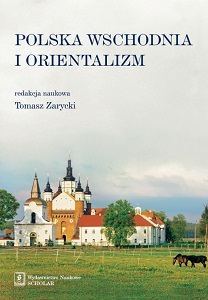
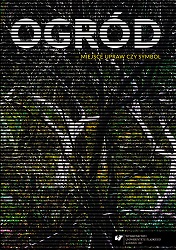
The first part of the book presents three main themes which, as a whole, are intended to bea framework for more specific descriptions in its second part. In the first chapter, entitled Realgardens against the myths, the author shows selected examples of landscape designs and discusses theirutilitarian functions, their role in the religious cult, the mythical, symbolic and metaphorical contextswhich have directly affected either programme assumptions of the gardens or a treatment of certainfeatures of the landscape. The cultures of Egypt, Mesopotamia, Greece and Rome are discussedin these respects. The author addresses the intellectual foundation of English and sentimentalgardens to clarify their strong ties with the ancient understanding of the landscape, describing onthis background meaningful features of Arcadia park near Nieborów. The chapter concludes witha discussion of selected solutions in Little Sparta — a garden founded by Sue and Ian Hamilton Finlaynear Edinburgh, Scotland. The second chapter, entitled Gardens of Imagination, discusses literarydescriptions, abstracted from specific landscape implementations. Several examples of literaturefrom different historical periods are invoked, with an emphasis on the role of sensuality. The authoranalyzes the fragments of the Egyptian Book of Gates, the epic of Gilgamesh, the Bible, Divine Comedyof Dante Alighieri, Charles Baudelaire’s Flowers of Evil. The third chapter, entitled The gardensof thought, raises general epistemological issues, first: in terms of the philosophical proposals forovercoming the fear of death, and second: in terms of theory of art viewed from the perspective of thetwentieth-century crisis of the great narrations.The common theme of all the chapters is the Garden of Eden, whose main intentional “function”is to overcome the fear of death. This issue is discussed in the context of eschatological, agnostic,and nihilistic intuitions, organized according to their relationship with specific gardens (Chapter 1),with the literary themes (Chapter 2), and finally with the abstract contemplation on the conditionof mankind and its representation in contemporary art (Chapter 3). Such a structure, inspired byHegel’s description of the history of the Absolute, makes it easier to present the problems of gardensfrom various perspectives — specific relations with nature, aesthetic experience and thought of purelyintellectual character. This approach, on the one hand, serves the clarity of argument by avoidingexcessive complexity of description, and on the other, shows the complexity of the concept of “garden”,resulting from the build-up of different meanings over the millennia.
More...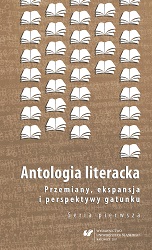
Keywords: anthology; young literary Silesia; regionalism; Marian Kisiel; Paweł Majerski; Dariusz Pawelec
The subject of the article is the phenomenon of the Silesian young poets anthologies published after 1989: Inny świt by Marian Kisiel, W swoją stronę by Paweł Majerski and Martwe punkty by Dariusz Pawelec. The poetry collections in question present a different kind of poetry created in Silesia – different meaning, on the one hand departing from manifesting regionalisms in literary works, dissenting from regarding being‑Silesian only in relation to poetic schemes, while on the other still recording this very quality, subconsciously registering it. The authors of the anthologies have been looking for a common sensitivity amongst the individualities of all writers whose works have been collected. Yet, what the published collections were to show above all, was that there is something happening in Silesian poetry, that it is not stuck in a rut, quite to the contrary: it is changing, moving forward, has its storms and revolutions, and that with each new author comes a new poetics.
More...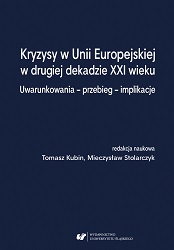
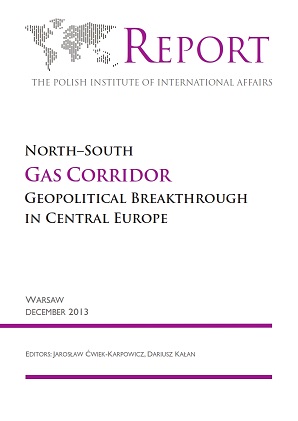
Keywords: European Union; North-South Gas Corridor; Visegrad Group V4; Russian suppliers; energy market; gas supplies; Western Balkans;
The need for the physical integration of EU markets via the North-South Gas Corridor (NSGC or NSI), today constitutes a flagship initiative of the Visegrad Group (V4) and its closest neighbours. The idea to build the gas corridor has arisen from both the geographical proximity of these countries and the similarity of the problems they face, including limited interconnections, poor market liquidity, and the dominance of Russian supplies. It is fair to say that the V4 was able to learn a lesson from the 2009 Russia–Ukraine gas crisis. All of the Visegrad members, which at the time had around 70–80% dependence on both supplies and transport routes from the east, were, to various degrees, hit by the temporary interruption of supplies. This was thus illustrative, not only of how diversification in Central Europe is needed but also of how regional solidarity is necessary to efficiently manage the risk of sudden cuts in the future. It is worth remembering that during the crisis the Czech Republic established reverse flow to Slovakia, while Hungary made emergency supplies from its stockpiles available to the Western Balkans.
More...
Keywords: European Union; importance of gas; North–South Gas Corridor; geopolitics; energy policy; transport of natural gas; EU legislation; energy security; alternative gas suppliers;
The forthcoming years should prove the strategic importance of gas. The gradual replacement of coal as part of the effort to meet the requirements of EU legislation, the growing number of plants producing subsided biogas, and the dramatic changes introduced by the dawning of unconventional gas in North America have created a window of opportunity for natural gas to become a fully-fledged energy resource. The role of gas in Europe will also increase when plans for re-industrialisation—seen by many as a crucial factor to prop up the EU economy—are implemented, since the main sector that consumes gas has been traditionally industry. These are the reasons for why one may predict that in Central Europe in the next 15 to 20 years, the share of natural gas in the overall energy mix will remain rather stable, and may even increase.
More...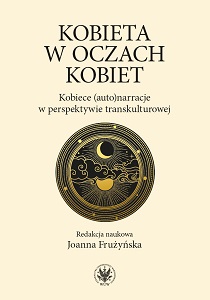
Keywords: journey; existence; memoir; eighteenth century; space
The article attempts to interpret the journey of Salomea Pilsztynowa, described in her memoiras of the eighteenth century. The peregrination of the main character is discussed in the context of sociological and existential aspects of travelling, with consideration of specifications of geo-poetics. The key issue is thus the relation between a location and a person, relation which describes the model of a journey and defines the traveller’s figure. The journey, created in the memoir, combines the features of experimental and existential tourism with wandering about without any plan.
More...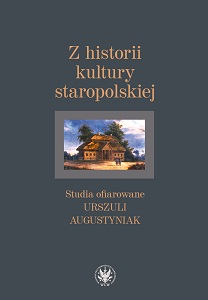
Keywords: Urszula Augustyniak; early modern history; early modern culture; history of religion; nobility; Radziwiłł family; reformation
Anniversary publication for Professor Urszula Augustyniak, affiliated with the Institute of History of the University of Warsaw, a renowned cultural historian specialized in the early modern period. Articles collected in the book are concerned with the broadly understood early modern history of culture, politics, and religion.
More...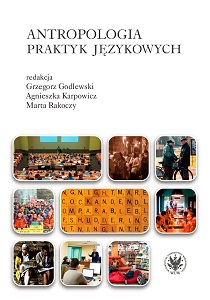
Keywords: language practice; cultural practice; word anthropology; linguistic anthropology
Development and concretisation of the original perspective concerning the word anthropology, which was formed at the Institute of Polish Culture at Warsaw University and used in language practice research. The perspective is considered the best method to perceive the language as cultural phenomenon. An extensive theoretical introduction justifies this approach and puts the undertaken research into the context of contemporary changes in cultural studies. The volume contains twelve articles which present study cases of language practice seen as cultural practice in historical context: from antiquity to modern times, from the forms of word art to swearing and searching the web.
More...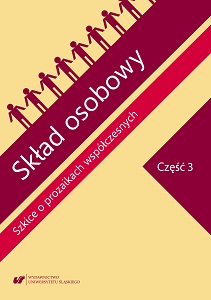
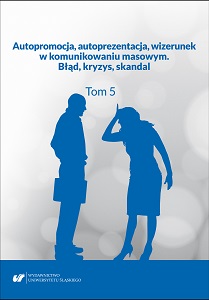
The subject of the article is the image of Częstochowa promoted in the pages of the periodical published by the Department of Culture, Promotion, and Sport of the City Hall. A specification of the general characteristics of the image has been combined with a description of the structure of the magazine which serves a functional tool for regional branding. The description has been arranged according to two segments (to which specific columns of the magazine can be assigned): the uniform image of the city and the system of communication between the local authorities and their target groups. The examination has been limited to the 2017 annual volume
More...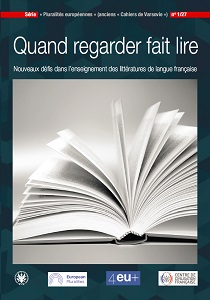
Keywords: online learning; humanities; history of culture; higher education; Sixties; French culture
The aim of this paper is to present the ideas that lay behind the conception of two online courses Artistic and literary life of Paris (19th-20th centuries) and The Sixties: The Beatles and Their Time designed for all the interested students of the University of Warsaw. The paper explains the organization of the course, presents its layout and the teaching methods used.
More...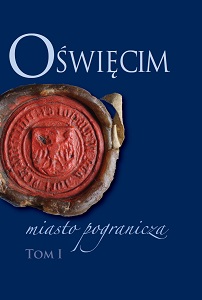
Keywords: Oświęcim; land of Oświęcim; history of Oświęcim; culture of Oświęcim; castle in Oświęcim; monuments of Oświęcim
Volume I of the monograph of Oświęcim contains a presentation of the history of the surrounding land and an analysis of cultural aspects of the city's functioning. At first the authors analyze changes in the boundaries and routes, and route names from the earliest times to the present, and then show the political history of the region, which repeatedly changed its national, administrative and diocesan affiliation. The second part of the volume discusses the development of architecture and art. in Oświęcim, including the most important monuments and silhouettes of the most eminent artists, as well as the development of education. Also, prominent figures from Oświęcim were presented. The volume closes with a calendar of the city's history.
More...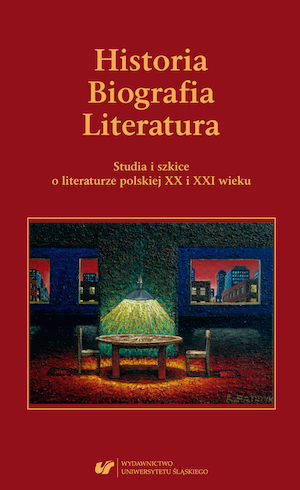
Keywords: Janusz Głowacki; Great Powers Tremble;August 1980;
The article constitutes an attempt at reviving the intriguing novel Great Powers Tremble by Janusz Głowacki (1981). The author recounts the events surrounding the writing of the novel and reconstructs the original contexts in which–following its launch and directly after that–it was discussed. First and foremost, however, the author is interested in the artistic and content-related potential of Głowacki’s novel, attempting to showcase its continued relevance, originality and the strength of expression contained in this fairly short and rather forgotten work. To this end, the author points to the peculiar, extremely successful and subversive at the same time creation of the anti-hero protagonist, and in the concluding parts of the article, he attempts to contrast Great Powers Tremble with the last work published while Głowacki (1939–2017) was still alive, a volume of stories entitled I Came (2013).
More...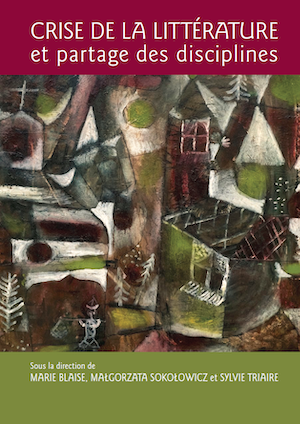
Keywords: octave; vanity; religious poetry; Renaissance; Protestant poetics
Before the fascination for vanity in painting, it existed, in late Renaissance France, a fascination for poetic vanities written by both Catholic and Protestant writers. However, the octonaire – an epigrammatic poem of eight verses that describes the vanity and inconstancy of the world – was invented by Protestant poets. Their poetry had to obey the rhetorical, literary and spiritual imperatives that were to incite the readers to hate the world and seek God. This article compares the book of poems of Antoine de la Roche Chandieu and the one of Joseph Du Chesne to highlight the differences between the two. These differences seem to reflect the tensions in Protestant poetics: between the simplicity of the biblical word and the splendor of the literary tradition.
More...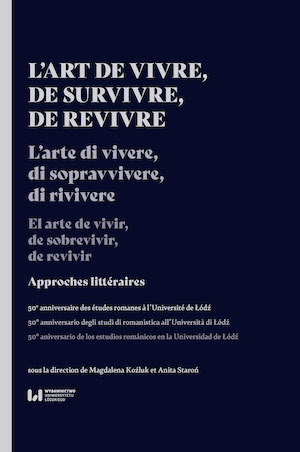
Keywords: epic; apocalypse; religious poetry; preface; rhetoric; renaissance
The aim of this article is to analyse the prefaces to the French Renaissance apocalyptic epics of the years 1576-1606 (works by Jacques de Billy, Guillaume de Chevalier, Michel Quillian and Jude Serclier) in order to understand the literary and extra-literary issues addressed by their authors. This comparison will highlight in particular the ethos of the author, the problem of representation in a biblical poem and its eschatological dimension, the place of pagan fiction and encyclopaedic erudition, and the rhetorical strategies employed.
More...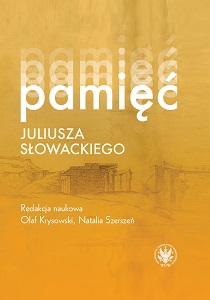
Keywords: staging; Juliusz Słowacki; Kordian; Jakub Skrzywanek; Romanticism; stereotype
The essay is an analysis and interpretation of Juliusz Słowacki’s "Kordian" directed by Jakub Skrzywanek at the Polish Theatre in Poznań in January 2018. Although it is a discussion with romantic stereotypes and myths, rather than another classical staging of the play, Skrzywanek’s staging is one of the most interesting voices in the "Kordian" case in years. This essay is an attempt to reconstruct the performance, made on the basis of its reviews and statements of the staging’s creators.
More...